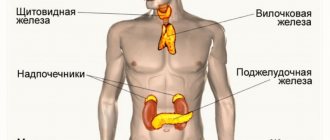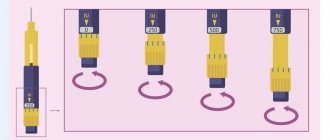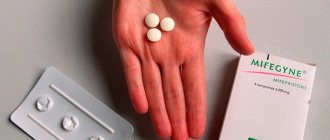Pharmacological properties of the drug Tropicamide-pharmak
Tropicamide (N-ethyl-alpha-(hydroxymethyl)-N-(4-pyridinylmethyl)benzoacetamide) blocks M-cholinergic receptors of the sphincter of the iris and ciliary muscle. Dilates the pupil, causing paralysis of accommodation. It acts quickly and does not last long. After a single instillation of 0.5% solution, pupil dilation begins after 5 minutes, reaches a maximum after 15–20 minutes and persists for 1 hour. Complete restoration of accommodation and pupil size occurs after 3–5 hours. After a single instillation of 1% solution -ra pupil dilation begins after 5 minutes, reaches a maximum after 20–45 minutes and persists for 2 hours. Maximum paralysis of accommodation after double instillation occurs 25 minutes from the moment of instillation and lasts about 30 minutes. Complete restoration of accommodation and pupil size occurs after 6 hours. It is slightly subject to systemic absorption (especially in children and the elderly).
Tropicamide: use as a drug
Initially, drug addicts used the substance to hide the constriction of the pupils of the eyes, which is a characteristic symptom when using most opium-based drugs. However, over time, they were able to discover one more property of this drug. When using a pribiotic, people under a narcotic potion felt its effects more strongly. Thus, they realized that this substance enhances the effect that drugs have on the human body. Thanks to this property, patients who had already suffered from drug addiction for a long time, for whom taking the next dose simply meant coming to their senses, were able to feel a real “high” again.
And in addition, drug addicts managed to save money, since taking the substance allowed them to reduce the dose of the drug they took by almost half. However, as they say, you have to pay for everything, and along with the intensification of the feelings of drug intoxication, the consequences of drug addiction also became stronger. The pains of drug withdrawal became so terrible and unbearable that most drug addicts could not stand it and committed suicide. In addition, as it turned out, the use of tropicamide itself caused drug intoxication in drug addicts. For this reason, many people tend to consider this medication a drug. But this substance is not a derivative of opium. Under the influence of the drug, drug addicts do not experience exactly the same sensations that they feel while under the influence of morphine, heroin, or something similar. These sensations are more similar to those that drug addicts experience when under the influence of hallucinogens.
These days there are many drug addicts who do not have the money to purchase drugs. And it didn’t cost anything to buy a product without a prescription for narcotic use, because its sale in pharmacies was not limited in any way a year ago. In addition, this drug was quite cheap. And although this substance is not a derivative of opium, it still poses a serious threat to humans. The “high” from tropicamide does not last long, no more than half an hour, and therefore drug addicts have to “run” to the pharmacy for the next portion several times a day.
Use of the drug Tropicamide-pharmak
To open the bottle, pierce the top of the neck by turning the cap all the way. Instill into the conjunctival sac of the eye by lightly pressing the walls of the bottle. Application of 0.5% solution To study the fundus of the eye - 1-2 drops over 15-20 minutes, to study the condition of the lens and determine refraction - 1-2 drops twice with an interval of 5 minutes, if necessary, prolong the mydriatic effect after 20-30 min additionally instill 1 drop of the drug. Application of 1% solution For fundus examination: 1–2 drops 20–45 minutes before the procedure. To study the condition of the lens and determine refraction: 1–2 drops twice with an interval of 5 minutes; if it is necessary to prolong the mydriatic effect, an additional 1 drop of the drug is instilled after 20–30 minutes. For therapeutic purposes, instill 1 drop into the conjunctival sac 2-3 times a day. The dose should not exceed 4 drops per day.
Signs of dangerous drops
After regular use, after about 2-3 weeks, signs become noticeable indicating that the drug has a detrimental effect on the body. Manifestations of addiction include:
- human skin acquires a grayish-yellow tint, which is explained by a rapid drop in hemoglobin in the blood;
- acceleration of the lacrimal glands;
- formation of ulcers on the skin;
- weight loss for no apparent reason;
- convulsions.
Suspicions about the use of drops arise if a person regularly becomes a client of a pharmacy, where he buys the drug in large quantities. Parents of teenagers and family members should be wary if a loved one has this drug and does not have chronic pathologies. In addition, the presence of strange objects in the home can also suggest that a loved one is addicted to drugs. For example, if he takes drops along with other drugs, these could be syringes, medicine bottles, a spoon with soot on it, or a tourniquet.
It is difficult not to notice the signs of addiction at serious stages. A person who gives himself injections prefers to wear long sleeves. This way he hides his tracks. A simple way to dispel terrible suspicions is to conduct a drug test. But the difficulty is that pharmacies do not detect the drug. Therefore, it is necessary to contact the laboratory of the RC Svoboda, where they will conduct an accurate and reliable analysis and confirm or refute the fears of worried relatives.
If the test detects the presence of a drug in the blood, it means the person is using it on a regular basis. This speaks of addiction. In this case, you shouldn’t hesitate: you need to seek help from the Svoboda RC.
Side effects of the drug Tropicamide-pharmak
From the organ of vision: increased intraocular pressure, impaired visual acuity, photophobia. Immediately after instillation of the drug, burning and lacrimation are possible, lasting for about 15–20 seconds. From the central nervous system: sometimes - psychotic symptoms, behavior changes (especially in children and adolescents), headache (in adults). From the cardiovascular system: symptoms of circulatory and respiratory failure (especially in children and adolescents), tachycardia (in adults). Other: dry mouth, allergic reactions.
Tropicamide - consequences of taking
The use of this medication to enhance the effect of drug intoxication caused by other drugs, or to hide the symptoms of drug use can lead to very serious consequences:
- Irreparable damage to the eyes is a sharp decline in vision, leading to blindness. The pupils are artificially dilated all the time, too much light falls on the retina, which over time begins to perceive light poorly, and sooner or later all this leads to the development of blindness;
- The addict's immune system is weakened. He becomes susceptible to many infectious diseases;
- The internal organs of a drug addict, as a result of prolonged intoxication, cannot withstand the load and cease to function normally - which leads to numerous metabolic disorders. In addition, use leads to the development of: nephritis, hepatitis, liver cirrhosis, toxic myocardial dystrophy - these are the most common consequences of use, which in most cases can lead to death;
- Development of organic damage to the human central nervous system. Encephalopathy, epilepsy, etc. In case of overdose, significant damage is also caused to the human body. The drug addict may fall into a comatose state, his body may be seized by convulsions, and in the case of a severe overdose, the person may stop breathing. In such situations, the addict needs urgent medical attention. He needs to cleanse the gastrointestinal tract and then give him a drug that can adsorb the remaining toxic substances.
Special instructions for the use of the drug Tropicamide-pharmak
Before using the drug when examining the fundus of the eye, especially in the elderly, it is necessary to examine the patient to identify possible angle-closure glaucoma (check the medical history, assess the depth of the anterior chamber, gonioscopy), since acute attacks of glaucoma are possible after using the drug. If an examination of the fundus is necessary, but an examination to detect glaucoma is not possible, a drug that constricts the pupil (pilocarpine hydrochloride, carbachol, etc.) should be administered immediately after the examination. For children, Tropicamide is prescribed only in the form of 0.5% solution. The use of the drug during pregnancy is possible only in cases where the expected benefit to the mother outweighs the potential risk to the fetus. Before using Tropicamide for diagnostic purposes, the patient or accompanying person should be warned about the possibility of temporary visual impairment and photophobia. To reduce systemic resorption, light pressure on the lacrimal sac area is recommended for 2–3 minutes after instillation of the drug. Before using Tropicamide, you must remove soft contact lenses. They can be put on again no earlier than 30 minutes after instillation of the drug. When using the drug, the patient should not engage in potentially hazardous activities that require increased attention (driving, etc.). Do not touch the dropper tip as this may cause microbial contamination of the contents of the container.
For what reason do drug addicts choose Tropicamide?
Like any medicine, Tropicamide should be used strictly as prescribed by your doctor. Exceeding the dosage may have side effects.
Drug addicts used the drug to dilate their pupils. In this way they tried to hide the fact of using a chemical substance: the drops relax the eye nerves and muscles, causing the pupil to dilate. This remedy was usually used by Opium users. But the seemingly harmless method of use has developed into a different use of medicinal drops.
Over time, another effect from the use of the drug was discovered. The action of the drops enhances the sensations of taking a narcotic substance, thereby helping to save the drug addict a dose, or enhance the existing effect of intoxication. A person who uses Tropicamide for non-medicinal purposes falls into a trap. On the one hand, it increases the pathological craving for drugs, on the other hand, over time, a persistent dependence on the drug is formed. In some cases, the addict experiences painful withdrawal symptoms from Tropicamide, but this does not always happen: most often when the drops are mixed with other chemicals.
Tropicamide gained popularity due to its availability, low cost, and pronounced intoxicating effect. The medicine contains a semi-synthetic psychoactive substance. It is methylenedioxymethamphetamine, abbreviated as MDMA. This substance is responsible for causing hallucinations in humans. In the jargon this is called "toons".
Signs of an overdose of Tropicamide with systemic use
- Violation of accommodation, pupil dilation. The addict stops seeing nearby objects and sees only at a distance.
- Dryness of the skin and mucous membranes of the eyes, mouth, nose, etc. leading to hyperthermia (body temperature rises). The skin has a waxy tint.
- Slowness and inability to swallow
- Increased heart rate - tachycardia
- Confusion, anxiety, hyperexcitability, seizures,
- Delusional and hallucinogenic syndromes
Fatal outcome from an overdose of tropicamide eye drops develops as a result of blockade of the respiratory center of the central nervous system.
If your loved one experiences all of the symptoms described above, call 112 immediately, life and its quality depend on every minute of delay.
Consequences of using Tropicamide
The use of these eye drops to obtain a dubious “high” quite quickly leads to the formation of mental dependence with an irresistible craving for the introduction of a new “dose”. After just a month of regular use, a person is unable to stop taking the drug on his own and requires qualified medical assistance.
Please note: The main reasons for the popularity of Tropicamide among drug addicts are the low cost of the drug and the free sale of this drug. Until 2015, eye drops were not included in the list of potent substances, and their circulation was not strictly controlled.
The consequences of using Tropicamide intravenously and intranasally have not been sufficiently studied to date. Doctors have every reason to believe that administering the drug in doses many times higher than therapeutic doses poses a real threat to human health. Loss of vision, development of epileptic seizures, and even tissue necrosis and detachment of skeletal muscles from bones are possible. Persons with an established addiction are characterized by a significant decrease in body weight (up to cachexia), deterioration of memory and cognitive abilities, as well as frequent dizziness even with complete cessation of the drug. The skin acquires a yellowish (waxy) tint, and the level of hemoglobin in the blood drops to critical levels. The most life-threatening effects of Tropicamide include respiratory depression and coma. The inevitable decrease in immunity greatly increases the risk of severe infections. Thus, the harm from the “pharmacy drug” Tropicamide is obvious. There is evidence that the life expectancy of a drug addict is reduced to 2 years.
Stopping taking this drug causes withdrawal symptoms, i.e. the syndrome is much stronger than after taking other psychotropic drugs. It is accompanied by severe muscle and joint pain, panic attacks and manifestations of aggression towards others.
Using a drug for other purposes often leads to poisoning. In case of an overdose of Tropicamide, slow intravenous administration of the antidote - physostigmine salicylate - is necessary. The required volume is determined at the rate of 0.03 mg per 1 kg of the victim’s body weight. In parallel, drugs from the group of β-blockers and benzodiazepines are administered.
Tropicamide
Tropicamide is produced in the form of eye drops in dosages of 0.5% and 1%. It is used in ophthalmology to study and diagnose diseases. The drug dilates the pupil, which makes it easier to examine the fundus. Drops are prescribed to treat inflammatory processes and eliminate adhesions between various eye tissues.
It should not be used if the patient has increased intraocular pressure, is diagnosed with glaucoma or eye hypersensitivity. Precautions should be taken when using Tropicamide, since the active component of the drug blocks the receptors of the eye. This is important for drivers and people engaged in work that requires a high level of attention and concentration.
Content:
- What is Tropicamide and its use in official medicine: 1.1. Legislative framework and sales in pharmacies.
- Effect on the body: 2.1. Signs of withdrawal. 2.2. Consequences of drug addiction.
- How to quit Tropicamide: principles of therapy.
According to the pharmacological classification, Tropicamide belongs to drugs that block M-cholinergic receptors of the central nervous system.
It itself has a pronounced psychoactive effect, but is often used to enhance the effects of other drugs. Thanks to its availability and legal sale in pharmacies, the drug has gained popularity among young people and teenagers, so the question of how to wean yourself off Tropicamide is especially acute among parents of high school and first-year students. Do these “harmless” eye drops really pose a health risk? Can they cause addiction?
How to quit Tropicamide: principles of therapy
Drug addiction treatment is carried out strictly in a hospital setting, where the patient is guaranteed not to be able to get another bottle of drops. If there are symptoms of an overdose (critical increase in body temperature, arrhythmia, breathing problems), resuscitation measures are necessary.
There is no specific antidote, therefore, to solve the problem of how to remove Tropicamide from the body, standard detoxification methods are used. This:
- intensive infusion-drop therapy using polyion solutions, plasma substitutes, etc.;
- active supportive treatment to restore systemic disorders: medications are administered to stabilize blood pressure, normalize heart rate, stimulate blood flow, antioxidants and hepatoprotectors are mandatory;
- prevention of complications from the central nervous system: tranquilizers or antipsychotics are administered (the latter are necessary for symptoms of acute psychosis).
But detoxification alone is not enough to stop Tropicamide. The patient needs long-term psychotherapy; suggestive coding methods have proven themselves to be effective. After completing the main course of treatment, you should definitely undergo rehabilitation
, ideally - on the basis of a specialized medical center, where they not only deal with the social adaptation of drug addicts, but also pay great attention to their physical recovery, healthy eating, and sports.
It is impossible to quit Tropicamide on your own! Therefore, you should not waste time trying to self-medicate, which will not bring any results. The drug is extremely toxic, so you need to contact a specialized specialist as soon as you notice symptoms of addiction in a loved one.
Treatment of tropicamide addiction in our center
Drug addiction to tropicamide is a serious disease, and even more so if it is associated with drug addiction to opium derivatives. But you can still recover from this disease. At this time, our specialists have already accumulated enough information about this disease, and they have extensive experience in treating drug addiction. If you or your loved one needs to get rid of drug addiction, there is no need to hesitate. Call us. Our clinic will provide you with effective and comprehensive assistance. ☎+7(495)773-03-43








